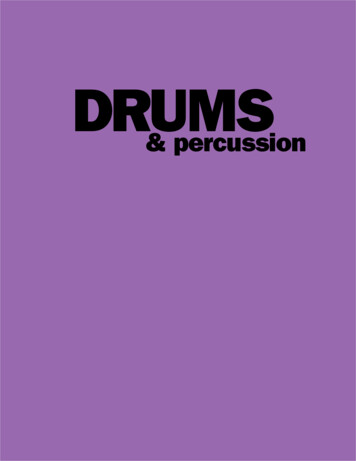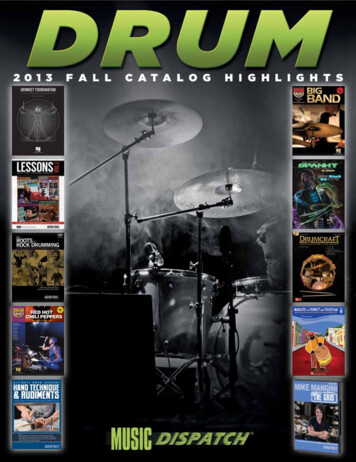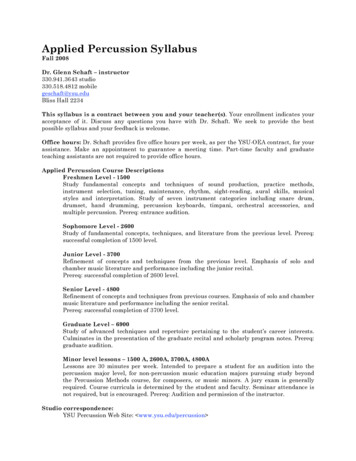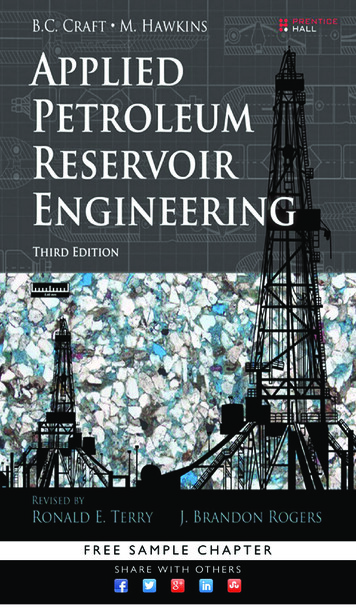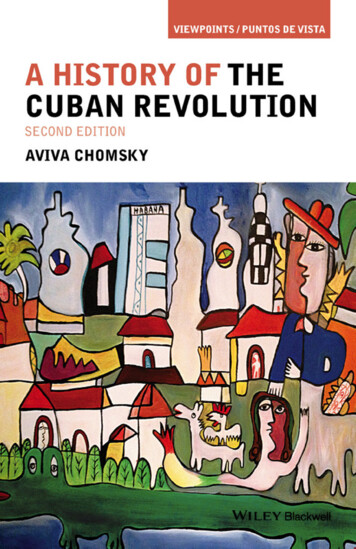
Transcription
A History of the Cuban Revolution
Viewpoints/Puntos de Vista:Themes and Interpretations in Latin American HistorySeries editor: Jürgen BuchenauThe books in this series will introduce students to the most significantthemes and topics in Latin American history. They represent a novelapproach to designing supplementary texts for this growing market.Intended as supplementary textbooks, the books will also discuss theways in which historians have interpreted these themes and topics, thusdemonstrating to students that our understanding of our past is constantly changing, through the emergence of new sources, methodologies,and historical theories. Unlike monographs, the books in this series willbe broad in scope and written in a style accessible to undergraduates.PublishedA History of the Cuban Revolution, Second EditionAviva ChomskyBartolomé de las Casas and the Conquest of the AmericasLawrence A. ClaytonBeyond Borders: A History of Mexican Migration to the United StatesTimothy J. HendersonThe Last Caudillo: Alvaro Obregón and the Mexican RevolutionJürgen BuchenauA Concise History of the Haitian RevolutionJeremy PopkinSpaniards in the Colonial Empire: Creoles vs. Peninsulars?Mark A. BurkholderDictatorship in South AmericaJerry DávilaMothers Making Latin AmericaErin E. O’Connor
A History of theCuban RevolutionSecond EditionAviva Chomsky
This edition first published 2015 2015 John Wiley & Sons, Inc.Edition history: John Wiley & Sons, Inc. (1e, 2011)Registered OfficeJohn Wiley & Sons, Ltd, The Atrium, Southern Gate, Chichester, West Sussex, PO19 8SQ, UKEditorial Offices350 Main Street, Malden, MA 02148‐5020, USA9600 Garsington Road, Oxford, OX4 2DQ, UKThe Atrium, Southern Gate, Chichester, West Sussex, PO19 8SQ, UKFor details of our global editorial offices, for customer services, and for information abouthow to apply for permission to reuse the copyright material in this book please see ourwebsite at www.wiley.com/wiley‐blackwell.The right of Aviva Chomsky to be identified as the authors of this work has been assertedin accordance with the UK Copyright, Designs and Patents Act 1988.All rights reserved. No part of this publication may be reproduced, stored in aretrieval system, or transmitted, in any form or by any means, electronic, mechanical,photocopying, recording or otherwise, except as permitted by the UK Copyright, Designsand Patents Act 1988, without the prior permission of the publisher.Wiley also publishes its books in a variety of electronic formats. Some content thatappears in print may not be available in electronic books.Designations used by companies to distinguish their products are often claimed astrademarks. All brand names and product names used in this book are trade names,service marks, trademarks or registered trademarks of their respective owners. Thepublisher is not associated with any product or vendor mentioned in this book.Limit of Liability/Disclaimer of Warranty: While the publisher and author have usedtheir best efforts in preparing this book, they make no representations or warrantieswith respect to the accuracy or completeness of the contents of this book and specificallydisclaim any implied warranties of merchantability or fitness for a particular purpose. Itis sold on the understanding that the publisher is not engaged in rendering professionalservices and neither the publisher nor the author shall be liable for damages arisingherefrom. If professional advice or other expert assistance is required, the services of acompetent professional should be sought.Library of Congress Cataloging‐in‐Publication DataChomsky, Aviva, 1957–A history of the Cuban Revolution / Aviva Chomsky. – Second edition.pages cmOriginal edition published in 2011.Includes bibliographical references and index.ISBN 978-1-118-94228-4 (pbk.)1. Cuba–History–Revolution, 1959. 2. Cuba–History–Revolution, 1959–Influence.I. Title.F1788.C465 2015972.9106′4–dc232014040325A catalogue record for this book is available from the British Library.Cover image: José Fuster, Untitled, 2003. Reproduced by kind permission of the artist.Collection of Janine & Joseph Gonyea III, Photograph by Jonathan B. Smith.Set in 10/12.5pt Minion by SPi Publisher Services, Pondicherry, India12015
ContentsList of Illustrations viiiSeries Editor’s Preface ixAcknowledgments xiTimeline xiiIntroduction 1Talking about Freedom 2Scholars Weigh In 3Why Revolution? 5Comparing Capitalism and Socialism 8Latin American Attitudes 121Cuba through 1959 15Colonial History 15The Colony in the Republic 20Revolution: A War, or a Process? 282Experiments with Socialism 36Analyzing the Situation: Economic Backwardness 37The 1960s: Experimentation and the Great Debate 40The 1970s: Institutionalization and the Soviet Model 45Cuba in the 1970s: How it Worked 461986: Rectification 51How Democratic was Cuban Socialism? 513Relations with the United States 54The United States and Cuba 55In their Own Words: U.S. Policymakers Respondto Revolution 57Covert War: Up to the Bay of Pigs 63
vi ContentsCovert War: After the Bay of Pigs 65The Missile Crisis 68After the Missile Crisis 70The War Continues 724Emigration and Internationalism 75Miami 78Beyond Miami 80Cuba’s Global Reach: Beyond the Cold War 81Cuba and Black Internationalism 82Cuba in Africa and Latin America 84Civilian Aid Missions 865Art, Culture, and Revolution 88Literature 89Film 94Music 98Sport 100Dance 102Food 103Political Culture and Cultural Politics 1056Cuba Diversa 110Race 110Gender 116Sexuality 119Religion 1237The “Special Period”: Socialism on One Island 1261993–95: Rapid‐Fire Reforms 126Social Impact of the Market Reforms 130Limits to Capitalism 132Charting New Territory 134Contradictions: Inequality and Jineterismo 135Opting to Leave: The 1994 Exodus 138Debate and its Limits during the 1990s 141Debating Democracy 142Limits to Debate 1468Cuba into the Twenty‐First Century 149From Perfeccionamiento to Recentralization 150Disillusionment 153Cuba after Fidel: A New Era? 155
Contents viiCivil Society into the New Century 159U.S. Policy: The Bush Era 163Cuba, Venezuela, and the ALBA 164Barack Obama and Raúl Castro: A New Relationship? 166Analyzing the Changes 168Conclusion 171Glossary 174Notes 177Bibliography 198Index 214
IllustrationsMapsMap 1 Cuba with major cities Map 2 Cuba with respect to the Caribbean and the Americas xvxviFiguresFigure I.1 Billboard quoting José Martí: “Either Free Forever, orForever Fighting to be Free” 2Figure 1.1 Bust of Hatuey in the main plaza of Baracoa in easternCuba. “Hatuey: The First Rebel of America. Burnedat the Stake in Yara, Baracoa.” Oriente Workers Lodge 16Figure 1.2 Print by Cuban artist Sandra Ramos, “Seremos comoel Che” (We will be like Che) 29Figure 2.1 Literacy Museum in Ciudad Libertad outsideof Havana, 2000 42Figure 3.1 Billboard near Playa Girón. “Girón: First Defeatof Yankee Imperialism in Latin America” 56Figure 5.1 ICAIC headquarters, Havana, 2008 95Figure 7.1 A bodega in Havana, 2009 127Figure 7.2 A dollar store in Havana, 2008 127Figure 7.3 A farmers’ market in Havana, 2000 129
Series Editor’s PrefaceEach book in the “Viewpoints/Puntos de Vista” series introduces students to a significant theme or topic in Latin American history. In anage in which student and faculty interest in the Global South increasinglychallenges the old focus on the history of Europe and North America,Latin American history has assumed an increasingly prominent positionin undergraduate curricula.Some of these books discuss the ways in which historians haveinterpreted these themes and topics, thus demonstrating that our understanding of our past is constantly changing, through the emergence ofnew sources, methodologies, and historical theories. Others offer anintroduction to a particular theme by means of a case study or biographyin a manner easily understood by the contemporary, non‐specialistreader. Yet others give an overview of a major theme that might serve asthe foundation of an upper‐level course.What is common to all of these books is their goal of historical synthesis. They draw on the insights of generations of scholarship on the mostenduring and fascinating issues in Latin American history, while alsomaking use of primary sources as appropriate. Each book is written by aspecialist in Latin American history who is concerned with undergraduate teaching, yet who has also made his or her mark as a first‐rate scholar.The books in this series can be used in a variety of ways, recognizingthe differences in teaching conditions at small liberal arts colleges, largepublic universities, and research‐oriented institutions with doctoralprograms. Faculty have particular needs depending on whether theyteach large lectures with discussion sections, small lecture or discussion‐oriented classes, or large lectures with no discussion sections, andwhether they teach on a semester or trimester system. The formatadopted for this series fits all of these different parameters.Now in its second edition, this volume was the inaugural book in the“Viewpoints/Puntos de Vista” series. In A History of the Cuban Revolution,
x Series Editor’s PrefaceAvi Chomsky provides a compelling and fascinating synthesis of theCuban Revolution. Drawing on historical literature and primary sourcesfrom Cuba, Europe, and the United States, the author takes the reader ona historical tour, from the beginning of the revolution in the SierraMaestra up to the present day. Along the way, Professor Chomsky coversthe emergence of Fidel Castro’s rule, the dramatic confrontation with theUnited States that included the Bay of Pigs invasion and the CubanMissile Crisis, before considering the revolution’s course and its socialand cultural legacies. The first edition of Professor Chomsky’s text was agreat success, and we are pleased to present a second edition. This newedition not only brings the story of the Cuban Revolution up to the present and adds a timeline and glossary, but it also updates ProfessorChomsky’s analysis as a result of the input from students, faculty, andnew scholarship that has appeared in the last five years.Jürgen BuchenauUniversity of North Carolina, Charlotte
AcknowledgmentsMany thanks to Peter Coveney and Jürgen Buchenau, who proposedthis project to me and who have helped it along at every juncture.Several anonymous readers provided welcome suggestions for both theproposal and the manuscript. Thanks also to copyeditor Gail Fergusonand to my sister‐in‐law Amy Apel for indexing the book. Above all, Imust thank Alfredo Prieto and his family. Alfredo has been my guide toCuba and socio in Cuba‐related intellectual and political endeavors overthe past decade. Hundreds of hours of conversations in Havana, Maine,Massachusetts, and even Miami, have helped me better understand thecomplexities of Cuba’s past and present. Alfredo also served as editorextraordinaire for this manuscript, catching errors, reminding me ofwhat I’d missed, and pushing me towards new discoveries. ¡Muchísimasgracias!
Timeline1493 Christopher Columbus lands in Cuba1868 Grito de Yara sets off Ten Years’ War (beginning of struggle forindependence)1879 Guerra Chiquita (second phase of war of independence)1886 Slavery abolished1891 José Martí publishes “Our America”1895 Cuban War of Independence renewed1898 U.S. intervention/Spanish Cuban American War1901 Constitution incorporates Platt Amendment1902 U.S. withdrawal1912 Massacre of Afro‐Cubans1920 CNOC founded; PCC founded1923 FEU founded1925 Gerardo Machado president1933 Machado overthrown, Carlos Manuel de Céspedes installed, thenreplaced by Ramón Grau San Martín1934 Constitution; Platt Amendment abrogated1940 Fulgencio Batista president; 1940 Constitution1947 Partido Ortodoxo founded1952 Coup by Fulgencio Batista1953 Failed attack on Moncada Barracks launches July 26th Movement1958 Granma sails from Mexico to Cuba1959 Cuban Revolution victorious; first Land Reform proclaimed;Casa de las Américas founded; ICAIC founded1960 Urban Reform Law; CDRs established; FMC established; U.S.imposes economic embargo and travel ban1961 Playa Girón (Bay of Pigs) invasion; literacy campaign; FidelCastro declares Revolution socialist
Timeline xiii1962 Missile Crisis1963 First Cuban medical mission abroad, in Algeria1965 UMAP established1966 U.S. passes Cuban Adjustment Act1970 Ten Million Ton harvest1972 Cuba joins COMECON1975 Partido Comunista de Cuba First Party Congress; U.S. SenateCommittee (Church Committee) investigation of assassinationplots against Fidel Castro; Cuba sends forces to Angola to helpMPLA repel South African invasion; Family Code1976 Constitution establishes Cuba as a socialist state1977 Cuban troops support Ethiopia against Somalia1980 Mariel Boatlift1982 Foreign investment code1986 Rectification campaign rolls back market openings1989 Collapse of Soviet bloc leads to economic crisis1991 Special Period in Time of Peace declared1992 Constitutional Amendments allow foreign investment in jointventures and declare Cuba a secular (rather than atheist) state;Torricelli Bill strengthens U.S. embargo1993 Dollar legalized; UBPCs created to cooperativize state farms1994 Farmers’ markets reinstituted; exodus of rafters1995 Clinton implements Wet Foot, Dry Foot policy; paladares authorized1996 Raúl Castro speech signals slowing of economic reforms; Helms‐Burton Act strengthens U.S. embargo1998 Cuba establishes Latin American Medical School; Pope John PaulII visits Cuba; Varela Project established; Hugo Chávez elected inVenezuela2000 Exception to trade embargo allows U.S. agricultural exports to Cuba2003 Convertible peso introduced; 75 dissidents arrested2004 ALBA launched, beginning with petroleum‐for‐doctors exchangebetween Cuba and Venezuela2006 Year of the Energy Revolution; Fidel Castro cedes presidencytemporarily to his brother Raúl and steps down as First Secretaryof the Communist Party2008 National Assembly elects Raúl Castro President of Cuba2009 Cuban authorities arrest USAID contractor Alan Gross
xiv Timeline2010 Dissidents arrested in 2003 freed in accord brokered by Spain andCatholic Church; self‐employment revitalized with new categories created and restrictions on size and employment of workerseased2011 Sixth Congress of the Communist Party of Cuba elects RaúlCastro as First Secretary, approves lineamientos (guidelines) foreconomic and political reform; new housing law allows Cubans tobuy and sell real estate2013 New migration law allows Cubans to travel abroad withoutobtaining an exit visa2014 Cubans permitted to purchase new, imported automobiles fromstate dealers
tsStra iGulf ofMexicoMarielilo rof FdaHAVANAPinardel üeyIsla de laJuventudLas TunasHolguínManzanilloCaribbean Sea0050CaymanIslands(U.K.)100 km50PicoTurquino100 milesMap 1â Cuba with major cities.BayamoSantiagode CubaGuantánamoU.S. Naval Base GuantanamoBay
USAAtlantic OceanTROPICMEXICOHavanaPacific OceanGUATEMALAEL SALVADORASURNDHOCUBANCO F CAITIHADOMINICAN PEPUBLICJAPUERTO RICOMAICANICARAGUA CaribbeanSeaTRINIDAD AND TOBAGOCOSTA RICAAMRINSUAYANCOLOMBIAGALAPAGOS ISLANDSGUVENEZUELAPANAMAECUADORMap 2â Cuba with respect to the Caribbean and the Americas.FRENCH GUIANAER
IntroductionRarely does popular opinion in the United States diverge so strikinglyfrom scholarly analysis as in the case of the Cuban Revolution.It’s one of the few events in Latin American history that U.S. studentshave heard of. When I ask my students to come up with names ofimportant figures in Latin American history, the only one that reliablyemerges is that of Fidel Castro. And students are fairly unanimous intheir opinions of Castro: “Dangerous,” “evil,” “bad,” and “dictator” are thewords they most commonly come up with to describe him. Survey resultsshow that my students’ positions are widely shared among the U.S. population: 98 percent of those surveyed in the United States had heard ofFidel Castro, and 82 percent had a negative opinion of him.1Fidel Castro has certainly inspired his share of scholarly attention,including numerous biographies. Some are by historians. Some are byjournalists. One is by a doctor. There is even a graphic novel recounting Fidel’s life. In a “spoken autobiography” the Cuban revolutionaryrecounted his own story of his life.2Most serious studies of the Cuban Revolution, though, focus less onthe figure of Fidel Castro and more on the process, the politics, and thepeople of the Cuban Revolution. Here we find a giant gap between whatscholars, including historians, have to say, and what U.S. political leadersand the general public seem to believe. Most historians frame the story ofthe Cuban Revolution with the long history of U.S. involvement in theisland and in the rest of the Caribbean. But politicians and the generalpublic have tended to see the USSR, rather than the United States, as themain factor explaining the nature of the Cuban Revolution. In thisA History of the Cuban Revolution, Second Edition. Aviva Chomsky. 2015 John Wiley & Sons, Inc. Published 2015 by John Wiley & Sons, Inc.
2 Introductionrespect, U.S. scholars today have more in common with their Cubancounterparts than they do with the U.S. public.Talking about FreedomBoth in Cuba and in the United States, the word “freedom” comes upfrequently in describing Cuba’s history and current realities. It’s a wordthat incorporates many different meanings. U.S. policymakers tend touse it to refer to freedom for private enterprise, while for Cuban policymakers it generally means freedom from U.S. interference. This dichotomyis nothing new. “The Cuban people want to be free as much from theforeigners who abuse the flag as from the citizens who violate it and willend up burying it,” wrote a Cuban nationalist organization in the 1920s,referring to the U.S. political and economic domination of the island, andto the Cubans who collaborated with the foreigners.3 Around the sametime, Cuban Communist Party founder Julio Antonio Mella publishedhis pamphlet entitled Cuba, A Nation That Has Never Been Free.And today, a billboard in Santa Clara proclaims “O libres para siempreo batallando siempre para ser libres,” over a painting of two giant hands,one black and one white, breaking free of a shackle (Figure I.1). “Eitherfree forever, or forever fighting to be free.” The contemporary use of theFigure I.1 Billboard quoting José Martí: “Either Free Forever, or ForeverFighting to be Free.” Source: Photo by Jackie McCabe.
Introduction 3image, and the quote by Cuban independence leader José Martí, clearlydraws a parallel between Cuba’s struggle for independence from Spain,its struggle for the abolition of slavery and for racial equality, and itsstruggle for national independence in the current era in the face of U.S.threats. “Freedom,” a Cuban high school student at the “Martyrs of Kent”high school told U.S. educator Jonathan Kozol in 1976, “means when youare free of international capitalistic exploitation!”4“Castro has taken no interest in international situation or in threat ofinternational Communism,” the U.S. Ambassador complained shortly afterthe Revolution. “I tried to explain significance of support of all peoples offree world in great struggle between freedom and slavery but do notbelieve he was particularly impressed.”5 The “freedom” that U.S. policymakers worried about incessantly in the first months of the Revolutionwas what the new revolutionary regime would mean for private enterprise.Real U.S. goals in Cuba, Assistant Secretary of State Roy Rubottom reiterated, included “receptivity to U.S. and free world capital and increasingtrade” and “access by the United States to essential Cuban resources.”6In late 2007, President Bush echoed the importance of private enterprise,the association of what he called “economic freedom” with political freedoms – and Cuba’s failures on both counts. “One of the great success storiesof the past century is the advance of economic and political freedom acrossLatin America,” Bush explained in a major policy speech. “In this room areofficials representing nations that are embracing the blessings of democraticgovernment and free enterprise.” However, “one country in our region stillisolates its people from the hope that freedom brings, and traps them in asystem that has failed them.”7 The one country, obviously, was Cuba.In Barack Obama’s first major speech on Cuba, before an audience ofCuban Americans in Miami in May 2008, he used the words “free” or“freedom” 33 times. “Never in my lifetime,” he announced, “have the people of Cuba known freedom My policy toward Cuba will be guidedby one word: Libertad.” He even quoted José Martí, saying “every momentis critical in the defense of freedom.” While explicitly distancing himselffrom Republican policies, Obama nevertheless vowed to maintain theU.S. embargo against Cuba.8Scholars Weigh InScholars of Latin America are less likely to share the U.S. administrations’infatuation with free markets. While economists are still divided on theissue, with the Chicago School holding fast to its free market principles,
4 Introductionhistorians tend to be a bit more leery of automatically equating free markets with political freedom. Economic liberalism, they remind us, wasimplemented in much of Latin America in the late nineteenth centurythrough “liberal dictatorships” like that of Porfirio Díaz in Mexico, whomaintained repressive, undemocratic governments while warmly welcoming U.S. investors. Since World War II, dictatorships in the SouthernCone and authoritarian democracies like Mexico have followed neoliberaleconomic advisers from the United States. And free market “economicmiracles” in Latin America have often had disastrous effects on the poor.9Latin Americanists have frequently found themselves at odds withU.S. policymakers regarding the region. The interdisciplinary field ofLatin American Studies came about in part as a result of the CubanRevolution, as the State Department sought to create cadres of expertswho could guide and implement U.S. policy by funding new LatinAmerican Studies programs at major U.S. universities. Historian ThomasSkidmore, in what Rolena Adorno called a “memorable and oft‐repeatedannouncement,” suggested in 1961 that “we are all sons and daughters ofFidel.”10 That is, the Cuban Revolution gave rise to an upsurge of government interest in Latin America, and funding for Latin American Studiesprograms in major U.S. universities. (Jan Knippers Black later revisedthis to suggest that U.S. Latin Americanists are Fidel Castro’s “illegitimateoffspring.”11) In 1995 Stanford political scientist Richard Fagen echoedSkidmore’s sentiment when, upon receiving the Latin American StudiesAssociation’s top scholarship award, he suggested “with my tongue onlyhalf‐way into my cheek” that the Cuban revolutionary leader would bethe most appropriate recipient because “at least in the United States, noone did more than Fidel Castro to stimulate the study of Latin Americain the 60s and 70s.”12 “Many members of my generation,” political scientistand former Latin American Studies Association (LASA) President PeterSmith reiterated in 2006, “went through graduate school with thanks toFidel Castro.”13“U.S. officials,” Smith continued, “expected the academic communityto promote U.S. policy goals. The National Defense Education Act (notethat name!) offered generous scholarships for the study of Latin America –on the mistaken assumption, of course, that newly trained area expertswould figure out ways to prevent or defeat revolutionary movements.”14As Smith and the others have suggested, the attempt largely backfired.Instead, LASA took a strong stand early on: “Scholarship must neverbecome a clandestine arm of U.S. policy.”15 New scholars trained in LatinAmerican Studies who spent time working in Latin America as often asnot turned into opponents of U.S. policy towards the region. LASA has
Introduction 5been particularly critical of U.S. policy towards Cuba, passing resolutionafter resolution condemning the trade and travel embargo and calling forfree academic exchange with the island. LASA has been especially rankledthat the State Department has refused to issue visas for Cuban scholars toparticipate in its Congresses, and in 2007 the organization moved its meetingfrom Boston to Montreal so that Cuban scholars could attend unimpeded,vowing to boycott the United States until the organization received aguarantee that its Cuban members would be allowed to participate.Nevertheless, the study of Cuba in the United States has frequently beencriticized for its ideological divides. Several essays in the Latin AmericanResearch Review – the journal of the Latin American Studies Association –have noted the weight of politics in Cuban studies. Marifeli Pérez‐Stableargued in 1991 that the Cold War construct of the “Cubanologist,” m odeledon monikers assigned to those who studied the Soviet bloc, should bereplaced by “Cubanist,” taking Cuban studies out of the Cold War paradigmand returning it to Latin America and following the pattern of “LatinAmericanist” or “Mexicanist.” Damián Fernández reiterated this stance afew years later, as did John Kirk and Peter McKenna in 1999.16In addition to the ideological bent that it brought to the field, anotherdrawback of the “Cubanology” approach has been an overemphasis onpolitics in studies of the Cuban Revolution. Historian Louis A. Pérezcomplained in 1992 that historians have woefully neglected the historyof the post‐revolutionary period. “After 1961, historians yield to p olitical scientists, sociologists, economists, and anthropologists – toCubanologists. The resulting anomaly is striking: for Cubanologists,there is no history before 1959; for historians, there is no history after1959.”17 Clearly, the Revolution was a political event. But it was also social,cultural, economic, artistic, and many other things. Every revolution seeksto bring about change, and the Cuban Revolution is no exception. Insome ways, people’s everyday lives were fundamentally changed by theRevolution. In other ways, the Revolution grew out of, and drew on,longstanding aspects of Cuban history and culture. A social history of theRevolution grows from the intersection of structures, policies, and theactions of ordinary people.Why Revolution?If historians’ main objective is to understand change over time, we tendto be especially attracted to the study of revolutions because, by definition, they offer concrete examples of a lot of change occurring in a rather
6 Introductionlimited time period. We want to know when and why revolutionsoccur, why they take the forms they do, and what their results are.Social historians in particular want to know how and why ordinary peoplemobilize for revolution, to what extent they are actors and participants inrevolutionary change, and how revolutions affect their lives. Both theCuban revolutionaries themselves, and the historians who have studiedthe Cuban Revolution, have utilized historical understandings of whatthey know about other revolutions.Uprisings by oppressed people – like slave and peasant rebellions –have existed as long as civilization has existed. But revolutions are morethan just uprisings – they are concerted attempts to reorganize society.Historians often categorize revolutions into political versus social revolutions. The former focus on changing the structures of governanceand the access of the population to political institutions; while the latteremphasize creating a new social and economic order.Cuba’s revolution in 1959 drew on a long revolutionary tradition, bothin Cuba and globally, at the same time that it responded to the immediaterealities of Cuba in the 1950s. The revolutionary traditions includedEuropean political and social revolutions of the nineteenth and earlytwentieth centuries, American anti‐colonial revolutions, and Cubans’own attempts from the mid‐nineteenth century on to achieve nationalindependence and social change.The global “Age of Revolution” marked by the American and FrenchRevolutions at the end of the eighteenth century also encompassed revolutions in thought and political philosophy known as the Enlightenment,when (primarily) European intellectuals began to argue that the socialorder is man‐made, rather than God‐given, and thus subject to humanagency. Enlightenment thought invited people to question existing politicaland social systems and try to imagine better ones.Out of this philosophical or intellectual movement grew a wide varietyof political philosophies, and political and social movements to try to putthe ideas into practice. The “Glorious Revolution” in England in 1688established a constitutional monarchy with a bill of rights, while theAmerican Revolution beginning in 1775 established national independence and did away with monarchy altogether. While these two wereprimarily political revolutions, the French Revolution in 1789 went furtherin challenging the social order as well as the political system. The HaitianRevolution may have begun as a political movement, but it quicklybecame a profound social revolution and war of national liberation in1791, as slaves rose up and dismantled the slave plantation system anddeclared independence from France.
Introduction 7None of the Latin American wars of independence that followed theHaitian Revolution were quite as revolutionary. But it’s also notable thatin the colonies most heavily reliant on slavery – Cuba and the otherislands of the Caribbean, as well as Brazil – there were no wars for independence in the early nineteenth century. Instead, the elites closed rankswith the colonial powers. The example of Haiti soured them not only onsocial revolution, but on any challenge to the political or social order. Ittook another 75 years – and the abolition of the slave trade and a globalrepudiation of the slave system – be
Latin American history has assumed an increasingly prominent position in undergraduate curricula. Some of these books discuss the ways in which historians have interpreted these themes and topics, thus demonstrating that our under - standing of
